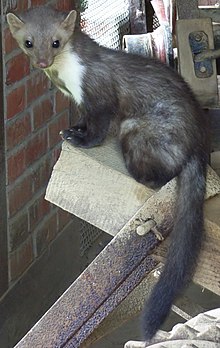Martes foina
| Beech marten | |
|---|---|
 |
|
| Scientific classification | |
| Kingdom: | Animalia |
| Phylum: | Chordata |
| Class: | Mammalia |
| Order: | Carnivora |
| Family: | Mustelidae |
| Genus: | Martes |
| Species: | M. foina |
| Binomial name | |
|
Martes foina (Erxleben, 1777) |
|
 |
|
| Beech marten range | |
The beech marten (Martes foina), also known as the stone marten, house marten or white breasted marten, is a species of marten native to much of Europe and Central Asia, though it has established a feral population in North America. It is listed as Least Concern by the IUCN on account of its wide distribution, its large population, and its presence in a number of protected areas. It is superficially similar to the pine marten, but differs from it by its smaller size and habitat preferences. While the pine marten is a forest specialist, the beech marten is a more generalist and adaptable species, occurring in a number of open and forest habitats.
Its most likely ancestor is Martes vetus, which also gave rise to the pine marten. The earliest M. vetus fossils were found in deposits dated to the Würm glaciation in Lebanon and Israel. The beech marten likely originated in the Near East or southwestern Asia, and may have arrived in Europe by the or the early Holocene. Thus, the beech marten differs from most other European mustelids of the Quaternary, as all other species (save for the European mink) appeared during the . Comparisons between fossil animals and their descendants indicate that the beech marten underwent a decrease in size beginning in the Würm period. Beech martens indigenous to the Aegean Islands represent a relic population with primitive Asiatic affinities.
The skull of the beech marten suggests a higher adaptation than the pine marten toward hypercarnivory, as indicated by its smaller head, shorter snout and its narrower post-orbital constriction and lesser emphasis on cheek teeth. Selective pressures must have acted to increase the beech marten's bite force at the expense of gape. These traits probably acted on male beech martens as a mechanism to avoid both intraspecific competition with females and interspecific competition with the ecologically overlapping pine marten.
...
Wikipedia

